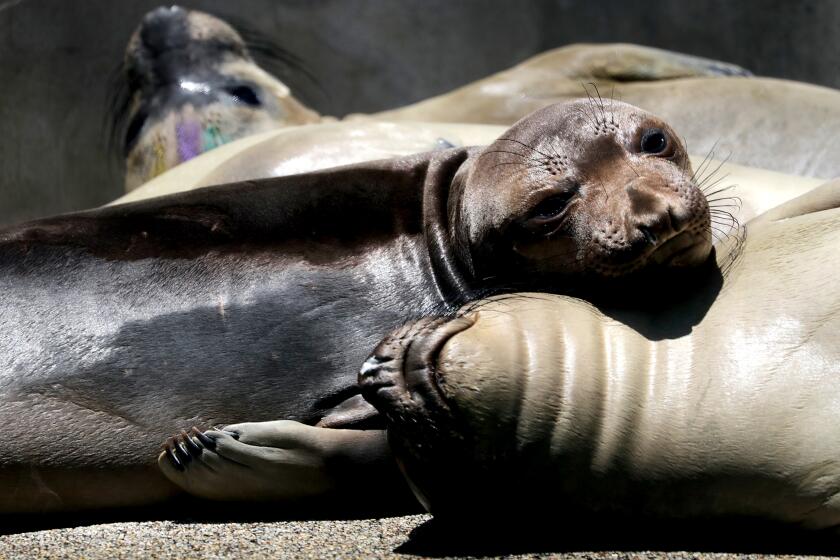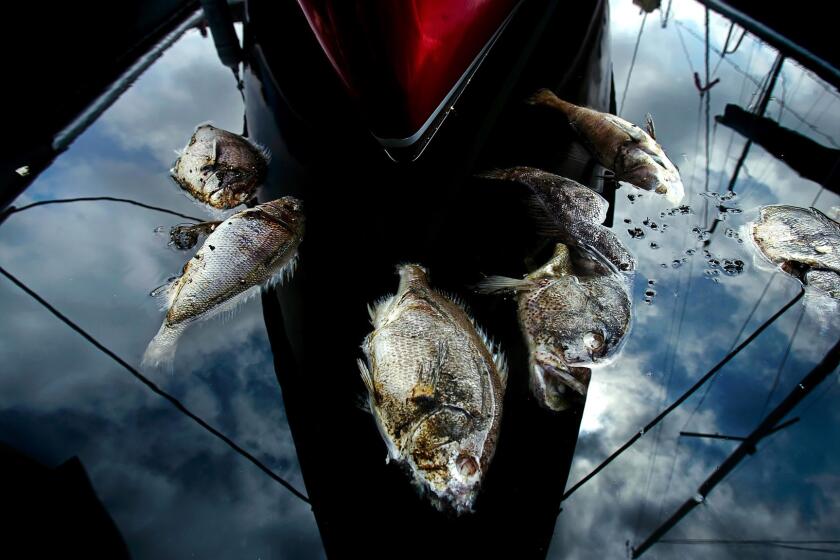Holiday beachgoers face an unexpected peril: aggressive, biting sea lions. Here’s what you can do
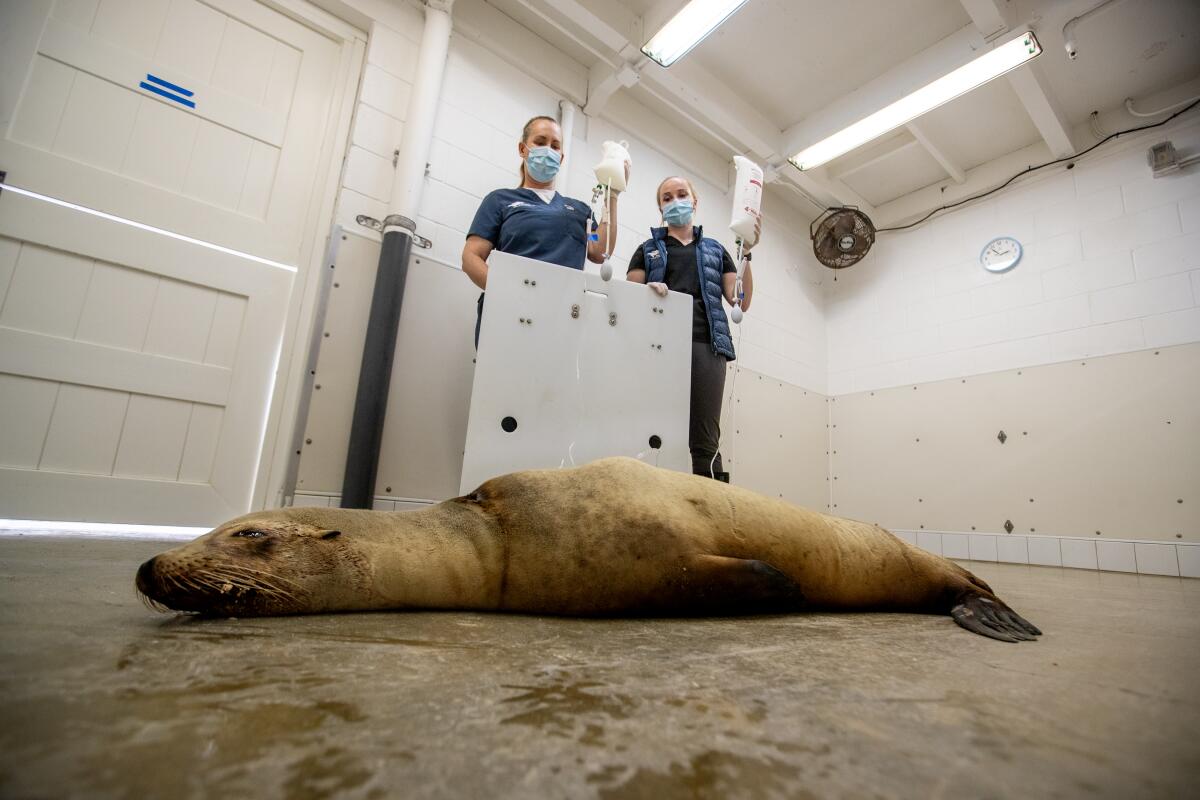
- Share via
As Southern Californians prepare to flood local beaches in anticipation of the Fourth of July holiday and an oncoming heat wave, experts are warning beachgoers to be vigilant about a surprising hazard: biting sea lions.
As of Tuesday, sea lions had injured at least two people at beaches in Orange County. Channel Islands Marine and Wildlife Institute, which serves Santa Barbara and Ventura counties, has recorded five recent incidents of animals biting beachgoers, including a surfer, paddle boarder, diver and two people on the beach, according to the facility’s executive director, Sam Dover.
So what is behind this unusual behavior — and what should you do if you’re bitten?
The marine mammals have been experiencing seizures or sickness by the hundreds because of an ongoing bloom of toxic algae, experts say.
But “it’s not like this is a rabid sea lion running down the beach chasing people and biting them,” said Dr. Alissa Deming of the Pacific Marine Mammal Center in Laguna Beach.
More than 1,000 marine mammals along the Southern California coast have gotten sick or died because of the bloom of toxic algae, according to the National Oceanic and Atmospheric Administration.
“They’re either running into surfers if they’re seizing erratically and accidentally biting them,” she said. “If someone touches them, they can be hyper-reactive and reflexively fly their head back. It’s not like they’re attacking — they’re in a comatose state and if they’re spooked or bump into something, they may bite.”
High concentrations of domoic acid — a neurotoxin produced by the marine algae Pseudo-nitzschia — were first found in waters near Santa Barbara and Ventura counties before making their way south to Los Angeles and Orange counties, according to Deming, the vice president of conservation medicine and science at the mammal center, which serves Orange County.
This algae bloom is one of the largest ever seen in the county, resulting in the most stranded sea lions the facility has dealt with, Deming said.
“This is the worst domoic acid event I’ve ever seen,” she said, “and I’ve worked here for over 10 years.”
Domoic acid events were first documented in the 1990s and have become increasingly common, more severe and longer-lasting in recent years. Algae blooms have historically been driven by climate change and ocean warming, particularly in El Niño years, when the ocean is warmer, and during years with a lot of rainfall, which results in the runoff of fertilizer, feeding the algae.
The algae, which grow during the spring and fall when the upwelling of water results in nutrients from deeper water rising to the surface, builds up in the food chain. Sea lions and dolphins eat the fish that consume the algae, resulting in brain damage, seizures and even death in the marine animals. The toxin doesn’t usually affect humans unless they eat contaminated food.
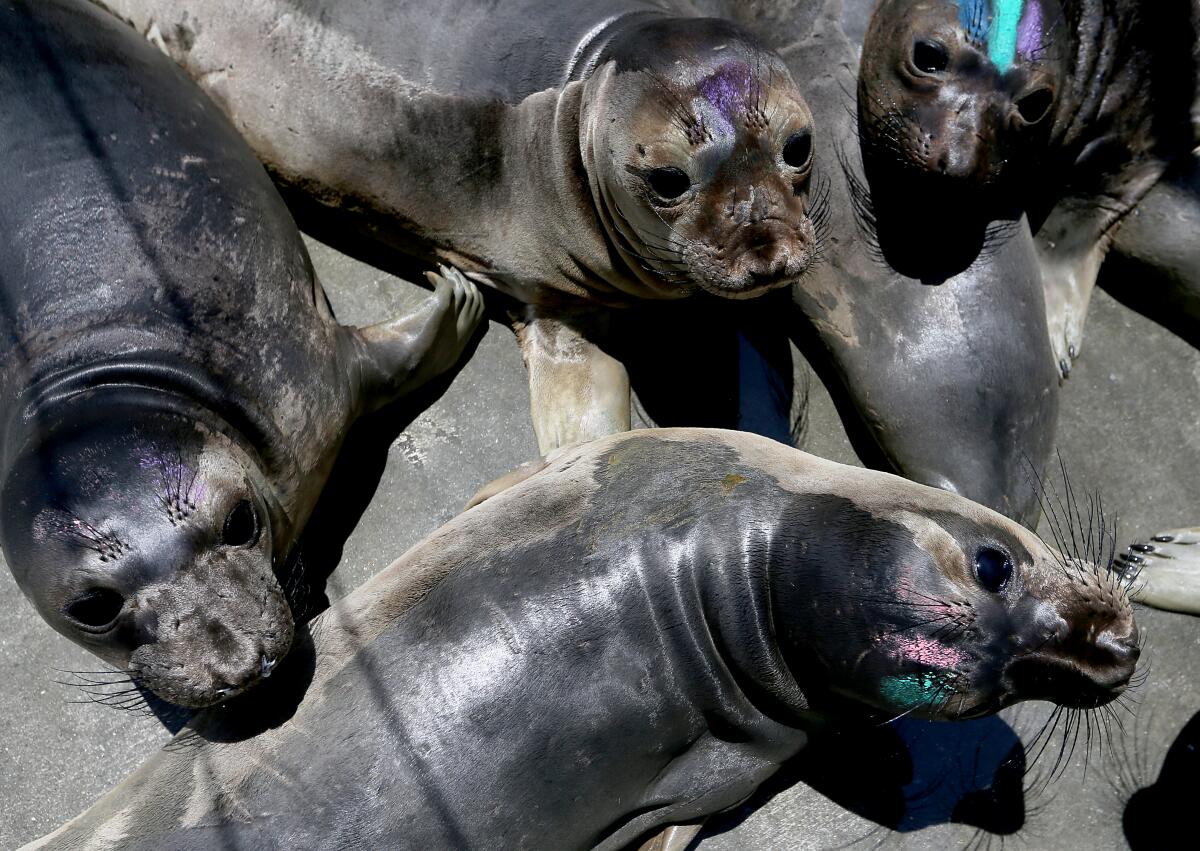
Deming recommends that, going into the holiday, the public be vigilant at beaches and try to stay at least 50 feet — the length of about four to six cars — from sea lions and other marine mammals. She also urged beachgoers to leash their dogs in case they were to approach any sickened sea lions and to follow the instructions of lifeguards.
“If people give that animal space,” Deming noted, “the chances of them getting bitten is very low.”
But some people frolicking in the water might not be aware of a sickened animal nearby. “Swimmers and surfers are more at risk,” she said.
If you’re bitten, Deming said to seek medical attention immediately. Bites can become infected with bacteria from the sea lion’s mouth or the ocean, and antibiotics could be necessary.
Humans aren’t at risk of getting sickened from domoic acid from a sea lion bite — they would have to consume it to be affected. This can happen through the seafood that is captured in areas during blooms. The California Department of Public Health routinely monitors the coast to sample shellfish such as clams, mussels and scallops to test for domoic acid toxins. Commercial shellfish harvesters are required to provide samples every week to the department for analysis.
Among the recent documented incidents was a boy who was bitten Monday by a sea lion at Salt Creek Beach in Dana Point. The child, who has not been publicly identified, was wading in the water about 20 feet from shore, according to Danielle Kennedy, a spokesperson for O.C. Parks. He was treated by lifeguards, released to a guardian and referred to urgent care for treatment. Lifeguards closed the beach out of caution.
Another injury caused by a sea lion was reported at Strands Beach at Salt Creek later that day, Kennedy said. The person declined to be treated; lifeguards then closed the water.
Salt Creek Beach was reopened Tuesday morning, and Strands Beach was reopened Wednesday morning. The public has been advised to contact a lifeguard if they see any sea lion, seal or other “aggressive marine mammals” in the area.
The National Oceanic and Atmospheric Administration reports that more than 1,000 marine mammals in Southern California have gotten sick or died this month due to the toxic algae.
The Los Angeles Unified School District has teamed up with the Marine Mammal Care Center in San Pedro, which serves Los Angeles County, to set up a triage space in the center’s parking lot that will allow the organization to care for an additional 20 animals at a time.
John Warner, the chief executive of the mammal care center, said during a Tuesday news conference that L.A. County had seen “high numbers” of sea lions stranded on its beaches because of domoic acid since the beginning of June.
The Marine Mammal Care Center is at capacity, with 113 animals — about 70 of them are sea lions with domoic acid toxicity. The rest of the animals are from pup season and aren’t ready to be released.
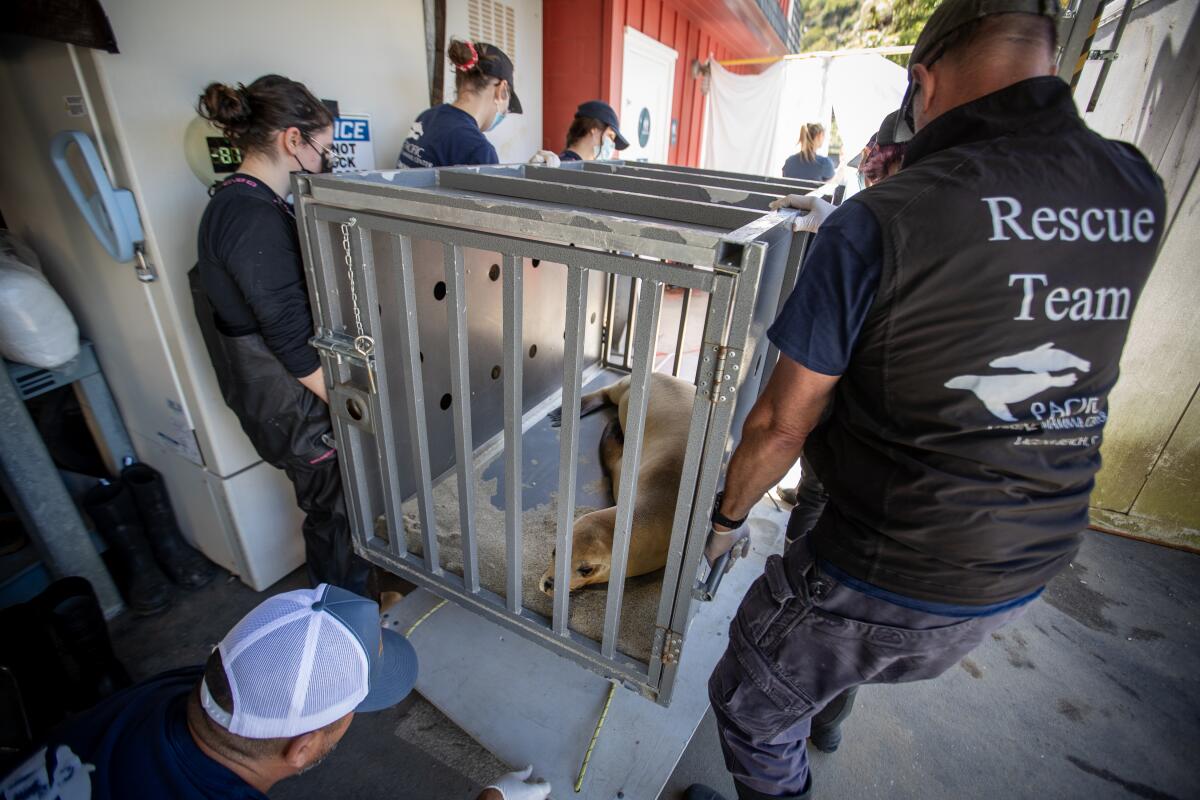
“That’s put additional strain on our capacity,” he said, “which in regular years is enough to care for the marine mammals stranded here.”
To care for the animals still stranded on beaches, Warner said the mammal center had partnered with city and county officials to set up a sea lion resting zone on Venice Beach to keep the animals sequestered from beachgoers.
L.A. Tri Club, a triathlon training organization, canceled its Friday Ocean Swim due to sea lions being affected by domoic acid. The club said it’s hosting a run instead.
“Our first priority is the safest of our swimmers,” according to a news release. “We will continue to monitor the reports of seal attacks closely alongside the L.A. County Lifeguards and provide an update for next week as soon as we have more information.”
West Hollywood Aquatics also canceled its ocean workout Thursday “out of an abundance of caution related to domoic acid/sea lion encounters.” The club will resume as expected starting July 6.
The Pacific Marine Mammal Center has rescued four to six sea lions a day, and it is approaching capacity, Deming said. There are about 70 animals there now, with more than half of them sickened sea lions; there’s space for about 10 to 15 more.
The center is working on setting up pens to accommodate 10 to 15 more animals with the hope that that would be enough for the Fourth of July weekend.
Dolphins have also been affected by the bloom of toxic algae, Deming said, but the poisoning is usually so severe that by the time rescuers get to the beach, the dolphins have died or are unresponsive to seizure medication and have to be euthanized.
The Pacific Marine Mammal Center has euthanized one dolphin and has responded to about eight to 10 dolphins that were already deceased or died while rescuers tended to the mammals.
Toxic algae that poison the brain have caused strandings and mass die-offs of marine mammals — barometers of the sea’s health.
When people come across a beached dolphin, Deming urges them to leave it alone even though their instinct may be to push it into the water. The dolphins beach themselves, she said, so they don’t drown during seizures.
Deming said the Pacific Marine Mammal Center had asked the city’s public works department and lifeguards to call the organization about deceased dolphins. The center has only three trucks and often is unable to pick up all of the animals about which they are alerted. In those cases, the center instructs public works employees to remove the dolphins from the beaches.
“We’re prioritizing live animals,” she added, “which is understandable.”
All the latest on Orange County from Orange County.
Get our free TimesOC newsletter.
You may occasionally receive promotional content from the Daily Pilot.
